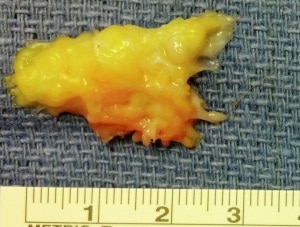A Morton’s Neuroma can be found in any interspace.
Symptoms of a Morton’s Neuroma in the Foot
Sharp or achy pain in the front part of the foot at the base of the toes.
Numbness, tingling, or a pins and needles feeling of the toes.
A sensation of feeling a lump on the bottom of the forefoot.
A feeling as if the sock is bunched up beneath the foot.
Feeling a clicking sensation when walking. There is a great video at the bottom of the page that will show you what happens to the nerve every time you feel that clicking and sharp pain.
No signs of redness or edema.
Treatment of a Neuroma
A proper history and physical examination by a neuroma specialist.
Tests such as Ultrasound or an MRI may be necessary to clearly make the diagnosis.
Conservative treatments include changes or modifications of shoe gear, orthotics,
foot padding, and the use of anti-inflammatory medication. Injections with steroid/cortisone can shrink the neuroma. Alcohol sclerosing injections can decrease the pain. It typically takes 8 alcohol sclerosing injections to treat a painful neuroma. The injections are done once every two weeks.
Surgery to Remove the Neuroma in the Foot
Radiofrequency ablation (RFA) is a great minimally invasive treatment option for neuroma pain.
Surgical treatment of neuroma may be needed to take out the neuroma for a cure. I use a special surgical technique to minimize the chance of a stump neuroma.
Healing after Neuroma Surgery
Most people will be walking right after surgery. We wait for the skin to heal up before increasing activities. Skin takes an average of 14-21 days to heal. During that healing time it is important to minimize swelling. Most patients get back to running about a month after surgery. The foot initially feels sore, but it is more comfortable when compared to the presurgical pain. The “sore” feeling can take 3-6 months to go away.
Complication of Neuroma Surgery
Most common complication that is talked about is a stump neuroma. A stump neuroma is where the proximal nerve ending does not heal correctly and continues to create pain in the foot. I use a special surgical technique to heavily minimize the chance of a stump neuroma. I wish we could say that we prevent 100% percent of stump neuromas, but that is impossible.
The other most common complication is swelling and scar tissue formation. Swelling is minimized by elevation and compression after surgery. Physical Therapy is a great modality to decrease scar tissue formation. It is very important to move your toes after surgery or else they will stiffen up.
Treatment of Stump Neuroma
Stump neuroma surgery is extremely difficult. Most of the time the incision needs to be made on the plantar aspect, bottom of the foot. The plantar incision increases chance of painful scar formation. It is very important to obtain a correct diagnosis and try all conservative treatment methods prior to going in for an excision of a stump neuroma. We are always available for a second option or surgical intervention where needed. Dr. Kolodenker is located in Irvine, CA. The best way to treat a stump neuroma is to never develop one in the first place.

Neuroma after surgery

Neuroma after surgery
Disclaimer
These videos are for information only. The contents of the videos, such as graphics, images, text, quoted information and all other materials (“Content”) are provided for reference only, do not claim to be complete or exhaustive or to be applicable to any particular individual’s medical condition. Viewers should always consult with a qualified and licensed physician or other medical care provider. Users are warned to follow the advice of their physicians without delay regardless of anything seen or read in these videos. OC Podiatry assumes no duty to correct or update the Content nor to resolve or clarify any inconsistent information that may be a part of the Content. Reliance on any Content is solely at the User’s risk. The videos may contain health or medically related materials considered sexually explicit. Users are warned that if they may be offended by such Content, an alternate source of information should be found. Publication of information or reference in videos to specific sources such as specific products, procedures, physicians, treatments, or diagnoses are for information only and are not endorsements.
Last Updated 11-14-2016


